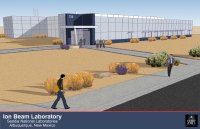Dec 17 2008
Groundbreaking for the new Ion Beam Laboratory is scheduled for Tuesday, Dec. 16 at 1 p.m. on Kirtland Air Force Base east of Sandia’s Processing Engineering & Technologies Lab (PETL) building.

A 15,000-square-foot building erected in 1956 for $150,000 and currently housing experimental equipment worth millions of dollars will give way to a 27,000-square-foot structure at a total project cost of approximately $39.6 million.
This figure includes constructing and equipping the new building, relocating personnel and existing equipment, and demolishing the old building.
Speakers for the groundbreaking ceremony will include Robert Smolen, deputy administrator for Defense Programs of the National Nuclear Security Administration, U.S. Rep. Heather Wilson (R-N.M.), Sandia Director Tom Hunter, and Joan Woodard, Sandia deputy director for Nuclear Weapons. The groundbreaking, performed by dignitaries with shovels, will follow brief introductory talks. Sandia researchers will be present to provide explanations of the various ion beam capabilities to be housed in the building.
The unique structure will contain six accelerator systems to generate heavy and light ions ranging from one electron volt to 400 million electron volts (eV).
One eV is enough to energize a single photon; 400 MeV will accelerate particles to seven percent of the speed of light.
The beams will be used for nuclear weapons programs, ion beam analysis, and radiation effects testing, as well as basic research and development and work for others.
“In this time of significant federal budget constraints, we are very appreciative that this critical capability has been given national priority,” says Joan Woodard.
The old building, sheet-metal-roofed, was emblematic of the spartan style of the early, post-World War II Sandia. It was originally used as a photo lab and to fold parachutes.
Nevertheless, it became the site of research that generated impressive national recognition.
Among testaments to the superior work accomplished there by a staff of (usually) seven were a 1990 DOE E. O. Lawrence award, nine Basic Energy Sciences awards, five R&D 100 awards, 17 patents, and more than 1,300 scientific publications.
Still, says researcher and building contact Barney Doyle, “The structure was intended as a temporary building. We’ve outgrown it spacewise and you can imagine the condition: roof leaks, floods, impacted science equipment.”
The cost of maintenance, possibility of increased downtime, insufficient radiation shielding in the crowded space for today’s more powerful beams, as well as potential insufficient beam stability when under scrutiny by more sensitive interrogating devices, were also issues.
There is so much equipment to move, and some new equipment to buy, that project manager Gilbert Aldaz considers construction of the new building to be only one-third of the task ahead.
“We have to pull all those accelerators and beam lines, take them out, crate, transport, uncrate, reassemble, and get them up and running,” he says. Of particular difficulty will be a 90,000-pound central tandem unit of a high-voltage Van de Graaff accelerator. “The central column is fragile, and it hasn’t been moved since the ’60s,” he says. “It’s sensitive to temperature and pressure changes. We’ll have to pick the right day, blanket it and support the column. It’ll take special rigging, a truck and probably a crane to get it into the new building.”
Three replacement pieces of equipment will also be installed: a 100 KeV nanoimplanter, a 3 MeV single-ended accelerator, and a new nuclear microprobe.
The list of research targets for the IBL is extensive. It includes research areas uniquely owned by Sandia in the DOE complex, including certification of tritium content in neutron tube targets, microscopic diagnostics of radiation sensitivity of integrated circuits, simulating the effects of the enormous fluxes of neutrons associated with nuclear detonations, and other calibrations and certifications for the nuclear stockpile.
Other areas of Sandia interest are materials studies that include corrosion rates of electronic components, composition analysis through use of high-energy beams, and materials modification through use of low-energy ion implanters to study and predict the corrosion of materials used in sensitive components.
Money was allocated by Congress partly in recognition of savings in the contingency construction funds for Sandia’s MESA project, which was completed $48 million under budget, says Bill Jenkins, a deputy director of the Weapon Engineering Program center.
The building is expected to be completed in 2009 and equipment installed by 2010.